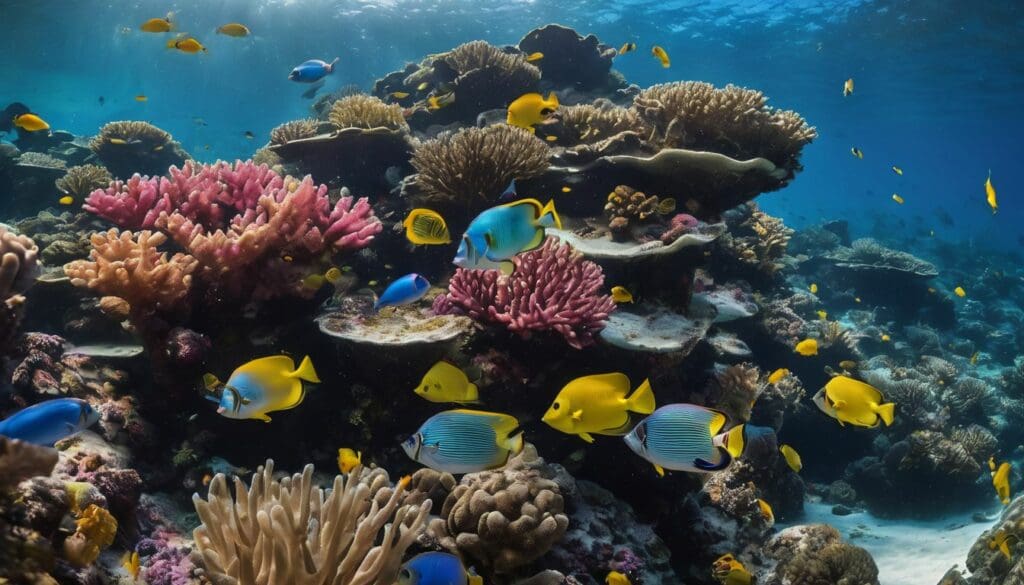The oceans teem with a wealth of life, yet they stand at a precarious crossroads owing to our actions. As devoted observers and stewards of this intricate ecosystem, it has become clear how paramount sustainable fishing practices are; an alarming one-third of global fish populations are currently reported as overfished.
Through our blog, we aim to share thoughtful insights on safeguarding our aquatic companions and ensuring that the briny deep continues to flourish in all its diversity for future generations.
Let’s make a splash together for positive change!
Key Takeaways
- Sustainable fishing helps to maintain the natural balance of marine ecosystems by preventing overfishing and allowing endangered species to recover.
- Advancements in sustainable fishing include reducing bycatch with selective gear and ecosystem-based management, considering the whole aquatic habitat.
- Marine Protected Areas (MPAs) work together with sustainable fishing practices to protect critical habitats and support ocean biodiversity.
- Voluntary commitments from fisheries can make a real difference in conserving endangered species like penguins, demonstrating responsible stewardship of our oceans.
- We can all contribute to marine conservation by choosing seafood that is certified as sustainable, supporting local fish populations, and being aware of the impacts of our consumption on aquatic biodiversity.
The Importance of Biodiversity in Aquatic Environments
The decline of biodiversity in aquatic environments is a pressing issue, with overfishing playing a significant role. It impacts the delicate balance of marine ecosystems and threatens the survival of various species.
Decline of Biodiversity
Our ocean’s biodiversity suffers as species are pushed to the brink of extinction. We see this happening when unsustainable fishing practices strip the marine ecosystem of its natural balance, causing a ripple effect that threatens aquatic wildlife across the globe.
Key populations plummet, disrupting food chains and weakening the health of our seas.
We must acknowledge that every net cast and line dropped has consequences. Fish numbers dwindle, once-thriving habitats become barren wastelands, and the rich tapestry of ocean life grows threadbare.
Bycatch—a grim byproduct of irresponsible fishing—snags dolphins, turtles, and birds alongside targeted fish stocks, demonstrating an urgent need for change in how we harvest from our waters.
It is imperative that we shift towards sustainable fisheries management to safeguard these vital underwater communities for future generations.
Role of Overfishing
Overfishing drastically reduces the number of fish in a particular area, disrupting the balance of marine life. It results in the depletion of certain species, affecting the overall biodiversity of aquatic environments.
Overfishing also leads to changes in food webs and ecosystems, impacting not only fish populations but also other marine organisms such as seabirds, mammals, and invertebrates. The removal of certain species due to overfishing can have cascading effects on the entire ecosystem, affecting its resilience and ability to adapt to environmental changes.
Furthermore, overfishing poses a significant threat to endangered species by depleting their populations even further. This jeopardises the long-term health and stability of aquatic habitats and endangers those dependent on these ecosystems for survival.
How Sustainable Fishing Supports Biodiversity Recovery
Sustainable fishing supports biodiversity recovery by promoting equal and shared access to resources, ensuring the benefits for endangered species and habitats. Through responsible fishing practices, we can help preserve aquatic biodiversity for future generations.
Equal and Shared Access to Resources
Equal and shared access to resources is crucial for sustainable fishing, ensuring that all stakeholders have a fair opportunity to benefit from aquatic resources. This approach promotes responsible fishing practices and helps prevent overexploitation of marine ecosystems, supporting the conservation of marine life and biodiversity.
By distributing access equitably, we can promote effective fisheries management and contribute to the preservation of aquatic habitats.
Promoting equal and shared access also fosters collaborative efforts among different parties involved in fisheries, leading to more sustainable practices and greater protection for endangered species.
It encourages environmental stewardship and supports the long-term health of our oceans. Through this inclusive approach, we empower communities to engage in responsible fishing activities while enhancing marine sustainability.
Benefits for Endangered Species and Habitats
Transitioning from the equitable access to resources, it’s important to highlight the benefits of sustainable fishing for endangered species and habitats. Through sustainable fishing practices, critical habitats like coral reefs, seagrass beds, and mangrove forests can be protected.
This approach also helps in reducing accidental capture (bycatch) of endangered marine animals such as sea turtles, dolphins, and sharks. By managing fisheries sustainably, we can ensure that endangered species have a chance to recover their populations and thrive in their natural environments.
Protecting the habitats of these species is essential in maintaining healthy ecosystems. Sustainable fishing not only offers protection to specific vulnerable species but also provides a framework for preserving entire aquatic ecosystems – from tiny microorganisms to large predators.
Advancements in Sustainable Fishing Practices
Advancements in sustainable fishing practices have made significant progress in reducing bycatch and implementing ecosystem-based fisheries management. These improvements aim to protect marine biodiversity and promote the long-term sustainability of aquatic habitats.
From Needing Improvement to Best Practice
Advancements in sustainable fishing practices have transitioned from needing improvement to best practice. Reduction of bycatch is now a key focus, minimising the incidental capture of non-target species while fishing.
Additionally, ecosystem-based fisheries management has become standard, ensuring that fishing practices consider the impact on the entire aquatic habitat, promoting marine conservation and preserving aquatic biodiversity.
In this shift towards best practice, sustainable fishing also incorporates technology and innovation to minimise its environmental footprint. By embracing these advancements and committing to sustainable seafood consumption, we contribute to the preservation of marine biodiversity and support the long-term sustainability of our oceans.
Reduction of Bycatch
To protect marine biodiversity, sustainable fishing practices focus on reducing bycatch. By implementing measures such as using selective fishing gear and modifying fishing techniques, we aim to minimise the accidental capture of non-target species like sea turtles, dolphins, and seabirds.
This reduction in bycatch helps to safeguard vulnerable species and maintain the delicate balance of aquatic ecosystems.
Implementing Turtle Excluder Devices (TEDs) in shrimp trawls is one effective strategy for decreasing sea turtle bycatch. Similarly, acoustic deterrent devices can prevent cetaceans from getting entangled in fishing gear.
Ecosystem-Based Fisheries Management
Advancements in sustainable fishing practices have led to the development of ecosystem-based fisheries management. This approach considers the entire ecosystem when making decisions about fishery management, aiming to maintain the health and resilience of aquatic habitats while balancing human needs.
By taking a holistic view of marine ecosystems, this strategy helps to ensure sustainable fishing practices that benefit both biodiversity and communities dependent on these resources.
This method involves comprehensive research and monitoring to understand the interactions between different species and their environments. It also incorporates adaptive management techniques, allowing for flexibility as new information becomes available.
Protection of Endangered Species
Voluntary commitments from fisheries have been made to protect endangered penguins, while the co-existence of marine protected areas and sustainable fishing ensures the conservation of threatened species.
Voluntary Commitments for Endangered Penguins
We can support the conservation of endangered penguins by encouraging and participating in voluntary commitments to protect their habitats. These commitments may involve advocating for marine protected areas, supporting sustainable fishing practices, or contributing to conservation organisations focused on preserving penguin populations.
By being mindful consumers and choosing seafood from sustainable sources, we actively contribute to the well-being of these remarkable aquatic birds. Taking part in initiatives aimed at raising awareness about the threats facing penguins and other marine species is crucial for their survival.
Moreover, collaborating with local communities, governments, and industry stakeholders to implement effective measures ensures a collective effort towards safeguarding penguin habitats.
Co-existence of Marine Protected Areas and Sustainable Fishing
Marine Protected Areas (MPAs) are essential for safeguarding critical habitats and marine biodiversity. Sustainable fishing practices, when carefully managed within these protected areas, can reduce the negative impact on aquatic ecosystems.
By regulating fishing activities in designated MPAs, endangered species have a chance to recover while maintaining balanced marine food webs. This co-existence supports the long-term preservation of aquatic habitats and contributes to overall ocean sustainability.
Furthermore, integrating sustainable fishing with MPAs promotes responsible resource management and encourages the conservation of marine biodiversity. It enables us to protect vulnerable species and their habitats while also providing sustainable seafood options for future generations.
The Role of Sustainable Fishing in Sustainable Food Production
“Sustainable fishing plays a crucial role in ensuring that our oceans can continue to provide food for generations to come. By promoting sustainable seafood consumption, we can support the conservation of aquatic biodiversity and maintain healthy marine ecosystems.”.
Supporting Marine Biodiversity Conventions
Supporting marine biodiversity conventions involves advocating for the implementation of policies and initiatives aimed at protecting and preserving aquatic habitats. By participating in these conventions, we can contribute to the conservation of marine ecosystems and the promotion of sustainable fishing practices.
This includes supporting efforts to establish marine protected areas, enforce regulations on catch limits, and encourage responsible fishing methods that minimise negative impacts on aquatic biodiversity.
Moreover, engaging with marine biodiversity conventions enables us to collaborate with stakeholders such as government bodies, non-profit organisations, and local communities to develop strategies for long-term ecosystem preservation.
By actively promoting these initiatives, we can play a key role in safeguarding endangered species and ensuring the health and resilience of our oceans for future generations.
Consuming Sustainable Seafood
Choosing sustainable seafood is crucial for safeguarding marine biodiversity. By making informed choices, we can contribute to the conservation of our oceans and support sustainable fishing practices.
- Look for certification from reputable organisations such as the Marine Stewardship Council (MSC) or Aquaculture Stewardship Council (ASC) when purchasing seafood.
- Consider consuming locally sourced fish that are in abundance in your region to reduce pressure on overfished species and minimise carbon footprint from transportation.
- Opt for smaller, fast – growing species with shorter lifespans, such as sardines and mussels, which are more resilient to fishing pressure.
- Avoid consuming seafood products from illegal, unreported, and unregulated (IUU) fishing vessels to prevent further depletion of marine resources.
- Educate yourself about sustainable seafood labels and guides to make informed choices when dining out or grocery shopping.
Conclusion
In conclusion, sustainable fishing plays a crucial role in preserving aquatic biodiversity. It helps to prevent the negative impact of overfishing on marine ecosystems and supports the recovery of endangered species.
By promoting sustainable seafood choices and advancing responsible fishing practices, we can contribute to the conservation of aquatic habitats worldwide. Our commitment to sustainable fishing is essential for ensuring a thriving marine environment for future generations.
FAQs
1. What is sustainable fishing and why is it important?
Sustainable fishing means catching fish without harming the future of fisheries or marine ecosystems, helping to preserve aquatic biodiversity.
2. How does overfishing impact biodiversity in our oceans?
Overfishing can reduce fish populations rapidly, which disturbs the balance of marine life and puts endangered species at greater risk.
3. Can choosing sustainable seafood make a difference?
Yes, when you support sustainable seafood, you’re helping promote healthy aquatic habitats and ensuring that fishing can continue safely into the future.
4. What actions help prevent overfishing and protect marine life?
Preventing overfishing involves managing fish stocks wisely, following rules for conservation, and working to protect endangered species within our oceans.





